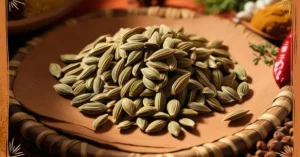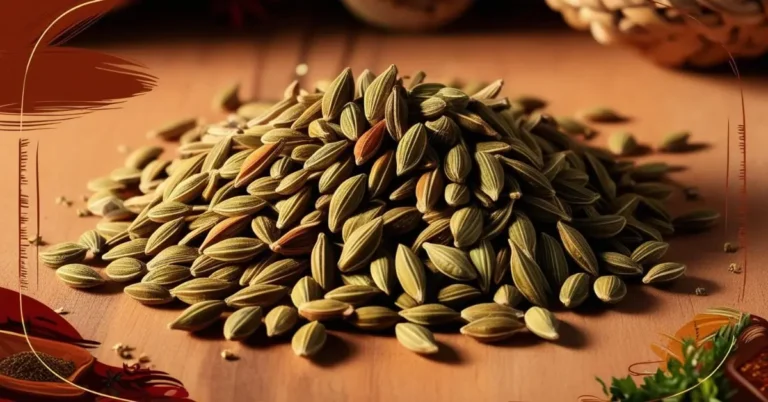Cumin seeds, derived from the Cuminum cyminum plant, have played a vital role in the culinary and medicinal traditions of various cultures for thousands of years. This tiny, oblong spice, typically brownish-yellow in color, is one of the most essential ingredients in global cuisines, revered for its distinctive aroma and flavor. However, cumin seeds are much more than just a spice—they are a treasure trove of health benefits, historical significance, and cultural importance. This article delves into the multifaceted nature of cumin seeds, exploring their history, cultivation, culinary uses, nutritional profile, medicinal properties, and their impact on modern cuisine.
Historical Significance of Cumin Seeds
Cumin’s history is as rich and varied as the cultures that have embraced it. Believed to have originated in the Mediterranean and Egypt, cumin was widely cultivated in ancient Egypt, where it was used as both a spice and a preservative, especially in the mummification process. The spice is even mentioned in the Old Testament, highlighting its long-standing role in the cultural and spiritual practices of early civilizations.
The Romans and Greeks were also fond of cumin, using it as a spice in their cooking and as a symbol of greed due to its strong, intense flavor. Cumin was so highly valued in these cultures that it was often kept on the dining table, much like salt and pepper today. The spread of cumin throughout Europe and Asia during the Middle Ages can be attributed to the spice trade, which facilitated the exchange of culinary and medicinal knowledge.
In Indian culture, cumin has been a staple for thousands of years. It is one of the primary ingredients in many traditional dishes and Ayurvedic medicines. The ancient Indian texts, such as the Charaka Samhita and Sushruta Samhita, document the use of cumin in treating various ailments, showcasing its long-standing importance in holistic medicine.
Cultivation and Production of Cumin
Cumin is predominantly grown in India, which is the world’s largest producer and consumer of cumin seeds, accounting for over 70% of global production. Other major producers include Iran, Turkey, Syria, and China. The cumin plant thrives in a warm, arid climate and is typically sown in the winter and harvested in the spring.
The plant itself is relatively low-maintenance, requiring minimal water and care. It grows to a height of 30 to 50 cm and produces small white or pink flowers that eventually give way to the cumin seeds. The seeds are harvested when they turn brownish-yellow and are then dried in the sun before being used in cooking or medicine.
The process of cultivating cumin is labor-intensive, as the seeds must be hand-harvested to ensure quality. After harvesting, the seeds undergo a drying process to reduce moisture content, which helps preserve their flavor and extends their shelf life. The dried seeds are then cleaned and sometimes roasted to enhance their flavor before being packaged for sale.
Culinary Uses of Cumin Seeds
Cumin seeds are a cornerstone of many global cuisines, particularly in South Asia, the Middle East, North Africa, and Latin America. Their warm, earthy flavor with a hint of bitterness adds depth to a wide variety of dishes. Here’s how cumin is utilized in various culinary traditions:
1. Indian Cuisine
- Curries and Gravies: Cumin is a key ingredient in Indian curries, lending its characteristic flavor to dishes like chicken curry, dal (lentil soup), and biryani. It is often combined with other spices like coriander, turmeric, and chili powder to create complex spice blends.
- Spice Blends: Garam masala and chaat masala, two iconic Indian spice blends, prominently feature cumin. It is also used in tempering (tadka), where cumin seeds are fried in oil or ghee to release their flavors before being added to dishes.
- Beverages: In India, cumin is used in beverages like jaljeera, a refreshing drink made with cumin, mint, lemon, and black salt. Cumin’s digestive properties make it a popular ingredient in such drinks.
2. Middle Eastern Cuisine
- Meats and Stews: In Middle Eastern cuisine, cumin is frequently used to season meats and stews. It is a key component of spice mixes like Baharat and Ras el Hanout, which are used in dishes like kebabs, tagines, and couscous.
- Dips and Sauces: Cumin is also an essential ingredient in hummus and other dips like baba ganoush. Its earthy flavor complements the creaminess of chickpeas and tahini, adding a layer of complexity to these popular dishes.
3. Mexican Cuisine
- Chili and Tacos: In Mexican cuisine, cumin is a critical spice in dishes like chili, tacos, and enchiladas. It is often combined with chili powder, garlic, and oregano to create the bold, smoky flavors characteristic of Mexican food.
- Spice Blends: Cumin is a staple in Mexican spice blends, including taco seasoning and adobo, which are used to flavor meats, beans, and vegetables.
4. North African Cuisine
- Couscous and Tagines: In North African cooking, cumin is used in spice blends like harissa and is a key flavor in dishes like couscous and tagines. It pairs well with other spices like coriander, cinnamon, and paprika to create the rich, aromatic flavors typical of North African cuisine.
5. Mediterranean Cuisine
- Soups and Salads: Cumin is used in Mediterranean soups and salads, often combined with lemon, garlic, and olive oil to create fresh, vibrant dishes. It is also used in Greek cuisine, particularly in meat dishes like keftedes (meatballs) and souvlaki (grilled meat skewers).
Nutritional Profile of Cumin Seeds
Cumin seeds are not only a flavorful addition to dishes but also a nutritional powerhouse. They are packed with essential nutrients, including:
- Vitamins: Cumin seeds are a good source of vitamins such as vitamin C, E, and K. Vitamin C acts as an antioxidant, supporting the immune system, while vitamin E contributes to skin health and vitamin K is essential for blood clotting.
- Minerals: Cumin seeds are rich in minerals like iron, calcium, magnesium, and potassium. Iron is crucial for the production of hemoglobin and red blood cells, making cumin particularly beneficial for individuals with anemia. Calcium and magnesium are vital for bone health, while potassium helps regulate blood pressure.
- Fiber: Cumin seeds are high in dietary fiber, which aids in digestion and promotes gut health. A diet rich in fiber can help prevent constipation, reduce cholesterol levels, and maintain a healthy weight.
- Protein: Although not a significant source of protein, cumin seeds contain small amounts of protein, contributing to the overall nutritional profile of this spice.
Medicinal Properties of Cumin Seeds

Cumin seeds have been used in traditional medicine for centuries, particularly in Ayurveda and traditional Chinese medicine. Modern research has supported many of these traditional uses, highlighting cumin’s potential health benefits. Some of the key medicinal properties of cumin seeds include:
1. Digestive Health
- Cumin is well-known for its digestive properties. It stimulates the production of digestive enzymes, which helps break down food and absorb nutrients more efficiently. Cumin seeds are often used to treat indigestion, bloating, and gas. In traditional practices, cumin is often combined with other spices like fennel and coriander to create digestive teas and remedies.
2. Antioxidant Properties
- Cumin seeds are rich in antioxidants, which help protect the body from oxidative stress and free radical damage. These antioxidants, including flavonoids and phenolic compounds, contribute to cumin’s anti-inflammatory and anti-cancer properties. Regular consumption of cumin may help reduce the risk of chronic diseases such as heart disease and cancer.
3. Anti-inflammatory Effects
- Cumin’s anti-inflammatory properties make it a valuable spice for managing inflammatory conditions such as arthritis. The presence of compounds like thymoquinone in cumin seeds helps reduce inflammation and pain, making it a natural remedy for various inflammatory disorders.
4. Blood Sugar Control
- Cumin has been shown to have hypoglycemic effects, making it beneficial for individuals with diabetes. It helps regulate blood sugar levels by improving insulin sensitivity and enhancing the body’s ability to utilize glucose. Incorporating cumin into the diet may help manage blood sugar levels and prevent complications associated with diabetes.
5. Immune Support
- The immune-boosting properties of cumin can be attributed to its high content of vitamin C and other antioxidants. Cumin helps strengthen the immune system, making the body more resistant to infections and illnesses. It is often used in traditional remedies to treat colds, flu, and other respiratory conditions.
6. Weight Loss
- Cumin may aid in weight loss by boosting metabolism and promoting fat burning. Studies have shown that cumin supplementation can lead to a reduction in body fat and improve overall body composition. Additionally, cumin’s ability to improve digestion and reduce bloating can help individuals feel lighter and more comfortable.
7. Skin and Hair Health
- The antioxidant and antimicrobial properties of cumin make it beneficial for skin and hair health. Cumin can help clear acne, reduce signs of aging, and promote a healthy complexion. For hair, cumin oil is often used to stimulate hair growth and prevent hair loss.
Cumin Seeds in Modern Cuisine
In contemporary cuisine, cumin continues to be a beloved spice, finding its place in both traditional and innovative dishes. As global cuisine becomes increasingly popular, cumin’s role in various culinary traditions is being celebrated and
adapted in new ways.
1. Fusion Cuisine
- Cumin is a popular spice in fusion cuisine, where chefs combine elements from different culinary traditions. For example, cumin might be used in a fusion dish that combines Indian and Mexican flavors, such as a cumin-spiced taco with a curry-inspired filling.
2. Health Foods
- With the rise of health-conscious eating, cumin has found its way into various health foods and supplements. It is often used in protein bars, health drinks, and superfood blends, valued for its nutritional benefits and flavor.
3. Artisanal Products
- Artisanal products like spice blends, infused oils, and flavored salts often feature cumin as a key ingredient. These products cater to consumers

